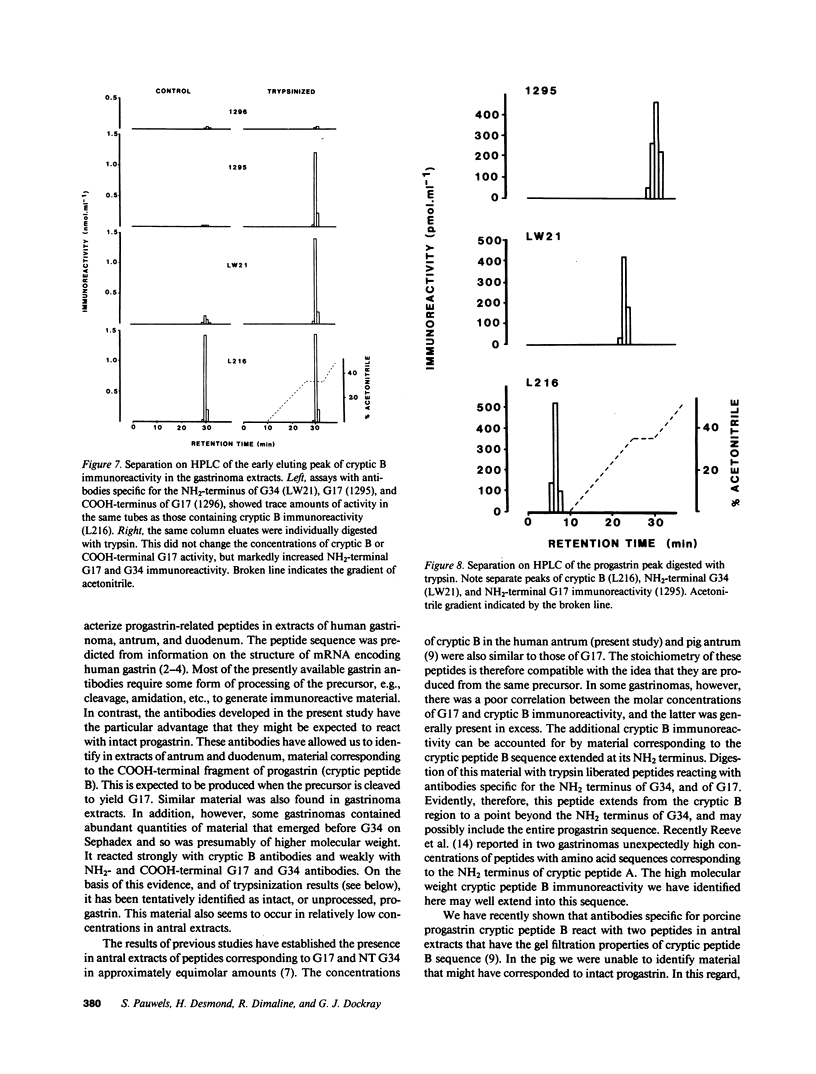Abstract
Recent studies on the gene sequence encoding the human pyloric antral hormone, gastrin, indicate a precursor of 101 residues. We have now raised antibodies to a synthetic analogue corresponding to (Tyr)-human progastrin COOH-terminal pentapeptide. The antibodies could be used in radioimmunoassay to measure this peptide, but they did not react with corresponding fragments of procholecystokinin, porcine progastrin, or other human progastrin-derived peptides, notably heptadecapeptide gastrin (G17), and 34-residue gastrin (G34). Radioimmunoassay of human antral and duodenal extracts revealed a major peak of activity that corresponded to the native COOH-terminal fragment of progastrin, and occurred in approximately equimolar amounts with COOH-terminal G17 immunoreactivity. In addition, there was a minor peak of apparently higher molecular weight material. In some gastrinomas the latter material was the predominant immunoreactive form, and it occurred in higher molar concentrations than any other form of gastrin. Digestion of this material with trypsin liberated peptides that reacted with antibodies specific for the NH2-terminus of G34, and G17. On this basis the high molecular weight component was identified as a form of gastrin that extended from the COOH-terminus of the precursor to a point at least beyond the NH2-terminus of G34, and probably included the entire progastrin sequence. The results suggest differences in posttranslational processing pathways of progastrin in antrum, duodenum, and gastrinomas. They also indicate that the present experimental approach allows the identification of progastrin-like substances, which should open the way to studying the mechanisms of gastrin biosynthesis.
Full text
PDF





Selected References
These references are in PubMed. This may not be the complete list of references from this article.
- Berson S. A., Yllow R. S. Nature of immunoreactive gastrin extracted from tissues of gastrointestinal tract. Gastroenterology. 1971 Feb;60(2):215–222. [PubMed] [Google Scholar]
- Boel E., Vuust J., Norris F., Norris K., Wind A., Rehfeld J. F., Marcker K. A. Molecular cloning of human gastrin cDNA: evidence for evolution of gastrin by gene duplication. Proc Natl Acad Sci U S A. 1983 May;80(10):2866–2869. doi: 10.1073/pnas.80.10.2866. [DOI] [PMC free article] [PubMed] [Google Scholar]
- Calam J., Dockray G. J., Walker R., Tracy H. J., Owens D. Molecular forms of gastrin in peptic ulcer: comparison of serum and tissue concentrations of G17 and G34 in gastric and duodenal ulcer subjects. Eur J Clin Invest. 1980 Jun;10(3):241–247. doi: 10.1111/j.1365-2362.1980.tb00027.x. [DOI] [PubMed] [Google Scholar]
- Desmond H., Dockray G. J., Spurdens M. Identification by specific radioimmunoassay of two novel peptides derived from the C-terminus of porcine preprogastrin. Regul Pept. 1985 Jun;11(2):133–142. doi: 10.1016/0167-0115(85)90073-4. [DOI] [PubMed] [Google Scholar]
- Dockray G. J., Vaillant C., Hopkins C. R. Biosynthetic relationships of big and little gastrins. Nature. 1978 Jun 29;273(5665):770–772. doi: 10.1038/273770a0. [DOI] [PubMed] [Google Scholar]
- Dockray G. J., Walsh J. H. Amino terminal gastrin fragment in serum of Zollinger-Ellison syndrome patients. Gastroenterology. 1975 Feb;68(2):222–230. [PubMed] [Google Scholar]
- Gregory R. A., Tracy H. J. Isolation of two "big gastrins" from Zollinger-Ellison tumour tissue. Lancet. 1972 Oct 14;2(7781):797–799. doi: 10.1016/s0140-6736(72)92151-4. [DOI] [PubMed] [Google Scholar]
- Heinrikson R. L., Meredith S. C. Amino acid analysis by reverse-phase high-performance liquid chromatography: precolumn derivatization with phenylisothiocyanate. Anal Biochem. 1984 Jan;136(1):65–74. doi: 10.1016/0003-2697(84)90307-5. [DOI] [PubMed] [Google Scholar]
- Ito R., Sato K., Helmer T., Jay G., Agarwal K. Structural analysis of the gene encoding human gastrin: the large intron contains an Alu sequence. Proc Natl Acad Sci U S A. 1984 Aug;81(15):4662–4666. doi: 10.1073/pnas.81.15.4662. [DOI] [PMC free article] [PubMed] [Google Scholar]
- Jonsson A. C., Dockray G. J. Immunohistochemical localization to pyloric antral G cells of peptides derived from porcine preprogastrin. Regul Pept. 1984 Jul;8(4):283–290. doi: 10.1016/0167-0115(84)90037-5. [DOI] [PubMed] [Google Scholar]
- Kato K., Himeno S., Takahashi Y., Wakabayashi T., Tarui S., Matsubara K. Molecular cloning of human gastrin precursor cDNA. Gene. 1983 Dec;26(1):53–57. doi: 10.1016/0378-1119(83)90035-5. [DOI] [PubMed] [Google Scholar]
- Malstrom J., Stadil F., Rehfeld J. F. Gastrins in tissue. Concentration and component pattern in gastric, duodenal, and jejunal mucosa of normal human subjects and patients with duodenal ulcer. Gastroenterology. 1976 May;70(5 PT1):697–703. [PubMed] [Google Scholar]
- Pauwels S., Dockray G. J., Walker R., Marcus S. Metabolism of heptadecapeptide gastrin in humans studied by region-specific antisera. J Clin Invest. 1985 Jun;75(6):2006–2013. doi: 10.1172/JCI111919. [DOI] [PMC free article] [PubMed] [Google Scholar]
- Pauwels S., Dockray G. J., Walker R., Marcus S. N-terminal tryptic fragment of big gastrin. Metabolism and failure to influence gastrin 17-evoked acid secretion in humans. Gastroenterology. 1984 Jan;86(1):86–92. [PubMed] [Google Scholar]
- Reeve J. R., Jr, Walsh J. H., Tompkins R. K., Hawke D., Shively J. E. Amino terminal fragments of human progastrin from gastrinoma. Biochem Biophys Res Commun. 1984 Aug 30;123(1):404–409. doi: 10.1016/0006-291x(84)90428-5. [DOI] [PubMed] [Google Scholar]
- Yoo O. J., Powell C. T., Agarwal K. L. Molecular cloning and nucleotide sequence of full-length of cDNA coding for porcine gastrin. Proc Natl Acad Sci U S A. 1982 Feb;79(4):1049–1053. doi: 10.1073/pnas.79.4.1049. [DOI] [PMC free article] [PubMed] [Google Scholar]


